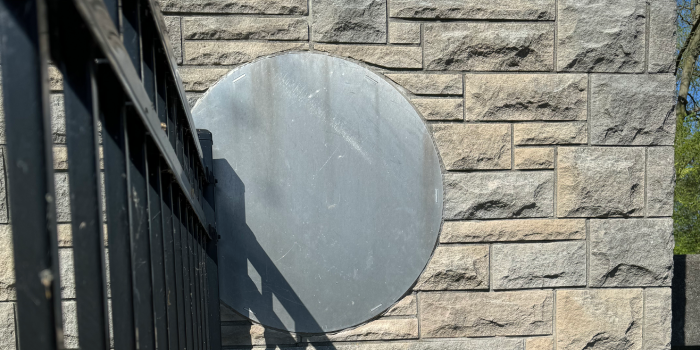
By Deb Patterson
InkFreeNews
SYRACUSE — A large water gauge that once could be seen on the exterior of the water control device building in Syracuse will be returned after years of absence.
Al Tehan, Syracuse, has restored that gauge, adding the latest technology to make it operable. He will reinstall the system in the next month or two after the fencing has been removed. The ultimate goal is to use the gauge to operate the control device gates as it was originally designed.
The gauge was originally installed in 1953. “It’s a wonderful piece of equipment,” Tehan stated at the quarterly meeting of the Turkey Creek Dam and Dike Conservancy District, Friday, April 26. “It’s an amazing piece of equipment. I think as the thing went through the years, it became in disrepair. Instead of spending any money, they kind of let it go.” Tehan acquired the gauge after being asked 10-12 years ago to recreate the gauge to once again display the lake level.
Tehan noted a paddlewheel, which he has, was used to gather data. The whereabouts of that data is unknown.
He has since reengineered the gauge’s system to once again show the water level and was ready to reinstall it in 2007. All that was needed was 110 volts to operate the gauge. “It’s still not in.”
Jim Silcox, district board member, and Tehan recently visited the gauge house. “There’s no electricity,” he stated. “It had all kinds of source for power going in there to power the gates, to power this, to power that. But it all had been disconnected over the years. So we’re starting from a clean slate. We have lots of options and technology at our fingertips.”
Since connecting with the conservancy district, Tehan has updated the gauge system with new electronics and technology. “It will display the actual level based upon the required level that was set … but we also thought if we have that data and we can track it by day, by week, by month, by year, could we get other input data … put it into an algorithm? And can we begin to predict and anticipate what’s going to happen to the level so we’re not always reactive?” said Tehan.
Tehan and others believe this can be done. “Technology is right for doing that … there’s a lot of that information … we could run it electronically. We could wake up some kind of electric motor once a day and move it (the gates) based upon information data … could make it eventually pretty accurate. We might move that thing an eighth of an inch, quarter of an inch in anticipation of an event …”
Tehan did state for the first several years somebody would have to go in and make the determination to raise the gates, just by pushing a button. “Eventually you might feel comfortable enough and comfortable saying this thing works, let it go. … Dream of what might happen. What we could do.”
Some of that data information was also presented by Herb Manford with Ecosystems Connections Institute. ECI is gathering data from its multiple devices already in the lake on water levels, temperatures, inflow and outflow. Additional devices will be added at Between the Lakes, at the water control device and downstream of the device.
These devices will provide better data to the town on how to manage the water control device level over time. The data collected will also provide information on how long it takes water from Lake Wawasee to get to Between the Lakes area, and out the water control device.
It was noted live feeds from these devices are available on the district’s website.
There was some discussion about the GPS not being accurate. Manford stated the GPS information is within 2 centimeters of accuracy, where handheld devices are within 4-6 feet. He further explained the equipment being used. Additional discussion was held regarding the location of the gauge at the railroad bridge.
Several questions were asked by Kyle Dietzen and Ken Eber regarding the data gathering, the dike being on private property, as well as the cost to pay an individual to inspect the water control device and dike and the town’s involvement.
At one point the conversation between Dietzen and Bill Pipp, district board president, became slightly heated, with Pipp suggesting the next time there is a board opening Dietzen should put his name on the slate.
Earlier in the meeting the board approved hiring Lawson Fisher to conduct the annual inspection on the two structures at a cost not to exceed $10,000.
Prior to adjournment of the meeting, the board voted to change the time for the Aug. 23 quarterly meeting from 4 p.m. to 2 p.m. due to a conflict at the WACF facility. The Oct. 25 quarterly meeting will remain at 4 p.m., with the annual meeting on Feb. 8, 2025, set for 9 a.m. and the first quarter meeting of the district to follow at 9:30 a.m.


